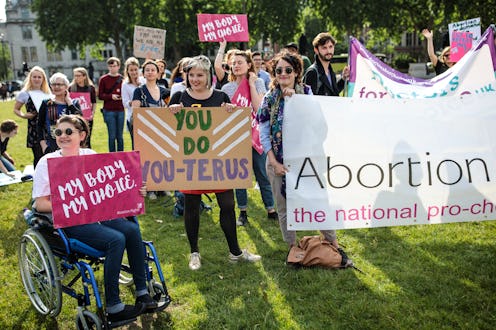News
These Abortion Statistics Show People Are Likely To Cross State Lines For Increased Access

New data from the Centers for Disease Control and Prevention (CDC) is providing some insight into how varying state restrictions on abortion access may be impacting residents in the United States. In fact, statistics show Oregon provides a number of abortions to non-residents, meaning people are crossing state lines to obtain the procedure.
According to the CDC, roughly 11.2 percent of abortions performed in Oregon in 2015 were provided to out-of-state residents. Of the 8,610 abortions performed in Oregon that year, the CDC noted that 7,847 were provided to Oregon residents, while another 763 were provided to those recorded as out-of-state residents.
While Oregon certainly isn't the only state reported by the CDC to have provided abortions to out-of-state residents, it appears to have provided the procedure to more out-of-state residents than most, if not all, of its neighbors. (Data from California was not available from the CDC.) Only 4.6 percent of abortions performed in the neighboring state of Idaho were reported to have been obtained by out-of-state residents. A similar percentage of 4.5 was reported in Washington, Oregon's northern neighbor.
What's more, according to the numbers, residents in Idaho obtained more abortions than were actually performed in the state, suggesting that a portion of the state's residents travelled across state lines to obtain the procedure. According to the Guttmacher Institute, Idaho currently has a number of abortion restrictions, including state-directed counseling and a mandatory 24 hour waiting period, which may deter women from seeking abortions in the state.
Oregon, however, has no such restrictions, according to Guttmacher. The state also allows nurse practitioners to perform abortions, something NARAL Pro-Choice Oregon's executive director told The Bend Bulletin has "really increased [abortion] access in small and rural communities." In fact, according to The Portland Mercury News, reproductive right activists largely consider Oregon to be the "gold standard" for abortion access.
But that's not to say that anti-choice advocates haven't attempted to pass measures that would restrict abortion access in the state. Earlier this year, Oregon voters overwhelmingly rejected a ballot measure 64.5 percent to 35.6 percent that aimed to prohibit any of the state's public funds from being used to cover the cost of an abortion procedure unless the mother's life was in danger.
According to The Oregonian, publicly-funded health insurance plans currently enable those covered to obtain an abortion when the procedure is approved by a medical professional. According to the paper, Oregon is one of only 17 states that allow state funds to be used to cover the cost of abortions.
When the measure was first brought up, reproductive rights advocates decreed it as an effort to restrict residents' access to health care. "Because at the end of the day, abortion is health care, and as we know here in Oregon, we believe everyone deserves access to the health care they need," Laurel Swerdlow, policy director of Planned Parenthood Advocates of Oregon, told Oregon Public Broadcasting.
But while recent data from the CDC showed that people are traveling across state lines to obtain abortions, data has also shown that the U.S. abortion rate is on the decline. According to NPR, data released last year revealed that fewer women obtained abortions in 2014 than have in any year since Roe v. Wade was decided in 1973. Women's health organizations, like Planned Parenthood credited the decline to improved access to contraception.